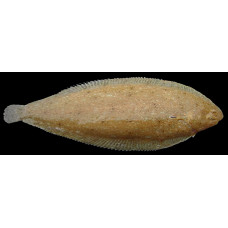Latin name
Solea solea
Other names
Dover sole, black sole.
Identification
The genus and species names come from the Latin Sole, meaning 'sole', because of the similarity of the shape of the sea tongue to the sole of a shoe.
Like other flatfish, hatches from the egg as a "normal" fish with one eye on each side of the body. Juveniles take on a "flounder-like" appearance when they are about one centimetre long.
The body is covered with fine scales, making the fish tough to the touch. Dorsal spines (total): 0; Dorsal soft rays (total): 69-97; Anal spines: 0; Anal soft rays: 53-80; Vertebrae: 46-52. Body oval, flat and asymmetrical; eyes on right side of head, except in inverted individuals. The anterior nostril on the blind side is not enlarged, but is surrounded by a small rim. the anterior nostril on the eye side has a tube directed backwards, not reaching or barely reaching the anterior edge of the lower eyelid. Mouth curved and deeper.
Features of fish fins
The dorsal and anal fins lack rays and are connected to the caudal fin by a well-developed ligament, but the caudal peduncle is distinct; the dorsal fin runs horizontally through the upper eye; the pectoral fin is asymmetrical on the eye side, with 7-10 rays, and slightly shorter on the blind side.
Fish colouring
Has a pale brown colour with dark patches. The eye side is greyish brown, the blind side is white.
Distribution
It is found in the eastern Atlantic Ocean, from southern Norway to Senegal, and almost throughout the Mediterranean. In winter they retreat to the slightly warmer waters of the southern North Sea.
Habitat
Prefers relatively shallow water (10-60m) with a sandy or muddy bottom, and can be found at depths of up to 200m. Preferred temperature range is 8-24°C.
Size
The maximum length is approximately 70 cm. The maximum declared weight is 3.0 kg.
Behavior
Usually solitary. Burrows in sandy and muddy bottoms. Move to deeper water in winter. Juveniles are found in coastal bays for the first 2-3 years before migrating to deeper waters.
The small eyes are close together on the right side of the body, giving the fish the ability to hide, half buried in the sand, in search of prey.
The maximum registered age is 26 years.
Food and feeding habits
It feeds at night. Its diet consists of worms, molluscs and crustaceans.
Reproduction
It reaches sexual maturity at the age of 3-5 years and then begins to reproduce. Spawning usually takes place from February to May, but in warmer regions it may occur in early winter. It usually takes place in shallow coastal waters at a temperature of 6-12°C. Once the eggs are fertilised, the incubation period is about five days. Metamorphosis occurs after about 35 days.
Fishing
Fish flesh has a soft, buttery, sweet flavour and is considered a delicacy and highly prized by gourmets.
| Classification | |
| Phylum | Chordata |
| Class | Actinopterygii |
| Squad | Pleuronectiformes |
| Family | Soleidae |
| Genus | Solea |
| Species | S. solea |
| Features | |
| Conservation status | Data Deficient |
| Habitat | Bottom |
| Life span, years | 26 |
| Maximum body weight, kg | 3 |
| Maximum length, cm | 70 |
| Sailing speed, m/s | No information |
| Threat to people | Edible |
| Way of eating | Not a predator |
Common sole
Tags: common sole


